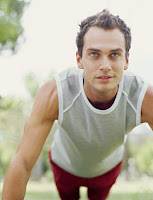The following is from my recent article on www.myyogaonline.com.
You’re finishing up your yoga class, you can almost feel sivasana coming, then the teacher instructs you to perform one last vinyasa. As you step back to plank pose, and begin to lower down into chaturanga or four legged staff pose, your shoulders dip forward from fatigue and your core refuses to co-operate as your belly sags to the floor. Chaturanga is an important, and even enjoyable, part of sun salutations and vinyasa flows. Keeping the integrity of the pose from the start to the end of our yoga practice is important to avoid injury and receive the many benefits chaturanga has to offer.
Let’s dissect this asana.
Preparation
Starting from plank pose, or high push up, our wrists are stacked under our shoulders and our body is parallel to the floor with our toes on the mat.

Upper Body
In plank pose the pectoralis muscles of the chest are keeping us in a push-up position. To avoid sagging into the wrist joints, a common complaint in this pose, we need to recruit the larger muscles of our shoulders for support. Imagine your heart moving closer to the floor, and without bending the elbows allow the shoulder blades to glide closer to each other. This actively engages our rhomboid muscles between the shoulder blades and the spine, and the middle portion of our diamond shaped trapezius muscle.
Core
In plank pose, to avoid sagging into the low back or popping up with our hips, our core muscles must be engaged. Use a gentle contraction of uddiyana bandha, sucking the belly button up and in, flattening the lower belly. This action corresponds to engaging the transversus abdominus, which provides stability to the lower spine. A slight tuck under of the tailbone can aid this action. To distribute the work away from our core and upper body, press back through the heels, sending weight into the legs.
Lower Body
With our heels pressing back like we are pressing into a wall, we are activating the muscles that dorsi flex our ankles, namely tibialis anterior on the front of the shin. Our hamstrings lengthened by the action of the extended knee initiated by our quadriceps muscles in the front of the thighs. To keep our alignment, our thighs are pressing towards each other but not touching, like we are holding a block with the adductor muscles of the groin.
To be continued......







